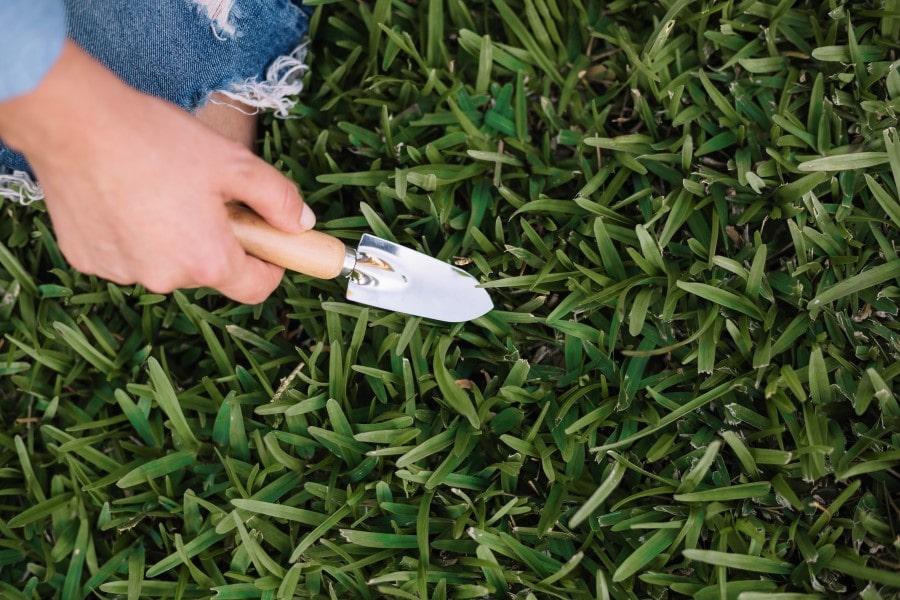How to Eliminate Weeds in Your Artificial Grass?


Let’s be honest, nobody dreams of weeds taking over their backyard haven. While artificial lawns offer the low-maintenance promise of endless summer, those pesky green invaders can still show up uninvited. Don’t let them crash your outdoor paradise! Here’s how to keep your artificial grass weed-free and picture-perfect.
Weed control is an essential element in maintaining the integrity and appearance of your artificial turf. Weeds in artificial grass not only detract from the beauty of your grass, but they can also seriously damage it.
As they grow, their roots delve into the infill, creating uneven surfaces and potentially tearing your precious lawn. Think bumpy putting green, but it’s not a relaxing retreat. Further to this, weeds can impede the drainage capabilities of your turf if left, resulting in waterlogging and related issues.
They disrupt the green dream. Artificial grass weeds are like uninvited guests at a party; they clash with the vibe and bring down the whole mood. Not exactly the serene oasis you envisioned, right?
A common misconception about fake turf is that weeds can’t grow through it. But the truth is, the dense construction of the synthetic material certainly acts as a deterrent, but some very hardy and determined weeds in artificial grass can and will find their way through if given the opportunity.
So, where does this usually happen? In most instances, if there are gaps or openings in the turf installation, weed seeds can find their way into the soil beneath the turf, where they can germinate and grow.
Several types of weeds can invade your artificial grass, and it’s important to be able to identify them in order to properly control them. Some of them are:
Proper identification is key to getting rid of them because each type of weed has different vulnerabilities, and the best way to successfully rid your artificial turf of any of them is to get those spot treatments down as quickly as you see them begin to grow.
Weeds in artificial grass can detract from its natural beauty, and they often create other problems as well. Some examples are:
Have you ever wondered how a weed manages to sprout on your perfectly fake lawn? Well, it turns out, there are a few party-crasher culprits:
The good news? With proper installation, clean infill, and a little maintenance, you can keep those party crashers out and your artificial oasis weed-free!
Now, let’s explore various methods to eliminate those pesky weeds and ensure your artificial lawn remains pristine.
Anticipating a lot of weed growth on your turf? If you only have a few weeds scattered throughout your artificial grass, you may remove them by hand, as manual weed removal may be your best option.
Begin by wearing gardening gloves to protect your hands. Gently pull out the weeds, taking care to grab each weed as close to the base as possible, removing it—root and all.
If you prefer eco-friendly methods, there are several natural remedies that can help combat weeds on your artificial lawn. Let’s see some of them:
When installing, you might consider using a weed-control fabric beneath the turf. This barrier prevents sunlight from reaching the underlying soil and prevents weed growth.
If all else fails, there are a variety of chemical herbicides that are safe to use on artificial grass and effective at killing weeds in synthetic grass.
Exercise caution when using chemicals, however, as they can potentially damage your artificial turf or harm the environment. Always be sure to follow the manufacturer’s instructions and use proper personal protective equipment, if advised.
Of course, as with many things in landscaping, good artificial turf maintenance is the key to keeping weeds from taking over your artificial lawn. By taking a proactive approach, you can make sure your turf looks great for years to come.
Regularly check for any signs of weeds in your synthetic grass. Keep in mind that weeds can grow even out of tiny cracks in your turf. If you see any invasive plants, remove them at once, no matter how small.
Remember to brush your turf to prevent debris and organic matter, which can become a prime weed-growing location, from collecting on its surface. Keep the space around your artificial lawn clean and free from potential sources of fake grass weeds, such as unruly plants or overhanging trees.
Maintain the vibrant look of your outdoor space by opting for our specialized service to clean artificial grass. Experience the difference as our dedicated team ensures your lawn stays impeccable. Contact our professionals today and let us revitalize the lush beauty of your artificial turf.
In conclusion, keeping weeds off your artificial grass is a must if you want it to remain a lovely, welcoming space for years to come. By understanding what causes weeds to grow and applying proper removal techniques, you can maintain a lawn that feels and looks like the real thing for a long time.
Whether you choose to pull fake grass weeds by hand, use earth-friendly solutions, or go the chemical route, never forget the importance of maintaining your lawn regularly. After all, it’s much easier to keep your artificial lawn weed-free than it is to jungle your dreams out of a real lawn. Keep your artificial lawn weed-free and enjoy the beauty of a perfect green oasis right in your backyard!

Festival Turf
Phone: 844-702-8873
Email: [email protected]
Las Vegas HQ Hours
Monday-Friday: 8:00am – 4:00pm PST
Saturday: 8:00am – 12:00pm
Sunday: CLOSED
Have a Question?
Contact us now and we’ll help you find what you need!

 Can Damaged Artificial Grass be Repaired?
Can Damaged Artificial Grass be Repaired?